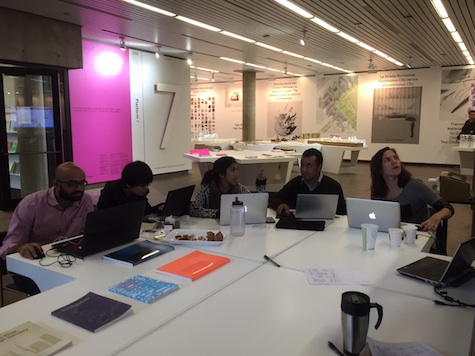Within hours of April 25’s magnitude 7.8 earthquake in Nepal, Harvard Graduate School of Design students had initiated support and advocacy projects in GSD’s Gund Hall and began collaborating with students and faculty from within Harvard and beyond, an energetic and transdisciplinary preface to the longer-term relief efforts now unfolding.
Dave Hampton and Shanika Hettige (both MDes ’16, concentrating in Risk and Resilience) oversaw the setup of a station in Gund’s lobby for Humanitarian OpenStreetMaps Team (HOT) task mapping of the affected region. Hettige also worked with Alberto Embriz De Salvatierra (MLA/MDes ‘17), as well as students from Harvard Business School, to create the website Nepal Quake Aid, which aggregates emergency service, mapping, and relief information and shares news on available resources.
“Analyzing risk and transforming it to resilience requires students who can work and act in an interdisciplinary manner that engages their expertise, but at the same time is flexible to collaboration across disciplines,” said Joyce Klein Rosenthal, assistant professor of urban planning at the GSD and co-coordinator of the Risk and Resilience program.
GSD efforts were sparked on the evening of Saturday, April 25, when Rosenthal forwarded to Risk and Resilience students an email seeking assistance in collecting data on building damage and displaced populations with HOT mapping tools. Hettige and others began to mine the web, while social media stoked their efforts by channeling information directly from people on the ground in Nepal and India.
De Salvatierra disabled his student portfolio page in order to host what would become Nepal Quake Aid and quickly established Facebook, Twitter, and Vimeo pages to supplement the website.
“Nepal Quake Aid is committed to connecting the larger Harvard community with the people of Nepal,” De Salvatierra said. “If people are cognizant of the difficult circumstances that lie ahead for the people and cities of Nepal, then it becomes an appeal not to a political cause, but to humanity.”
As mapping data continued to flow in over the course of the weekend, Hampton set up what was initially a makeshift station in the lobby of Gund on Monday morning. Within hours, the cluster of tables evolved into a cross-campus inquiry hub, with students from Harvard’s T.H. Chan School of Public Health and the John F. Kennedy School of Government, as well as MIT and Tufts, joining GSD participants in both data collection and broader discussion and inquiry.
Hettige herself spent twelve hours manning the station that Monday before traveling with Kirti Joshi, a Fulbright Visiting Scholar from Nepal, to spend the rest of the week in Washington, D.C., attending a summit on applying OpenStreetMaps data to disaster situations just like this.
Even with a hectic end-of-year schedule, Hettige said she considers the time commitment to this ongoing relief effort worthwhile.
“Although unfortunate circumstances,” she said, “there is an opportunity here to assist in saving the lives of others, to actively do what I have always been working towards, and to create change in areas of the world I am passionate about.”
